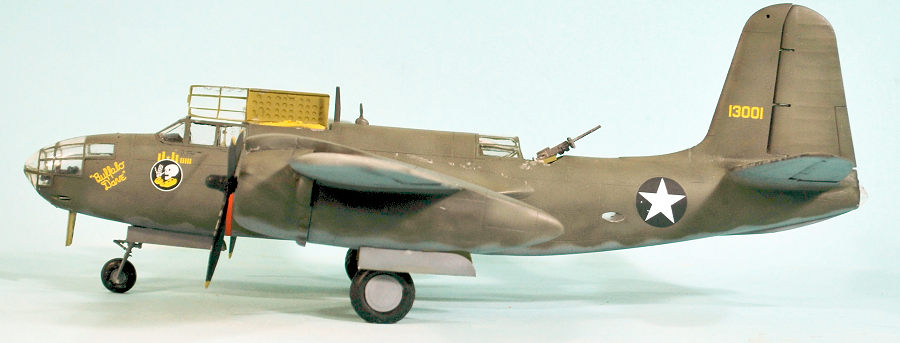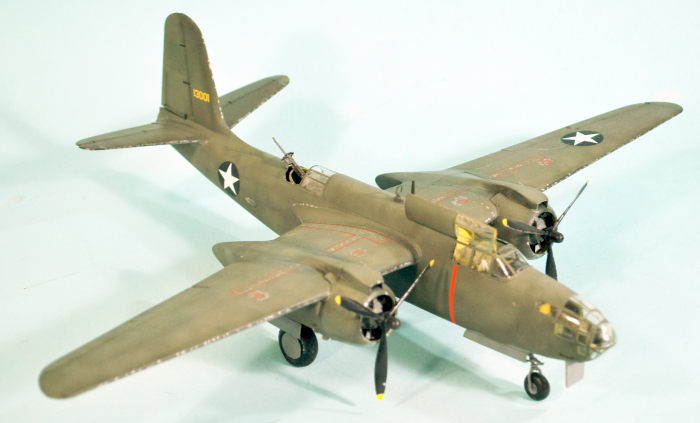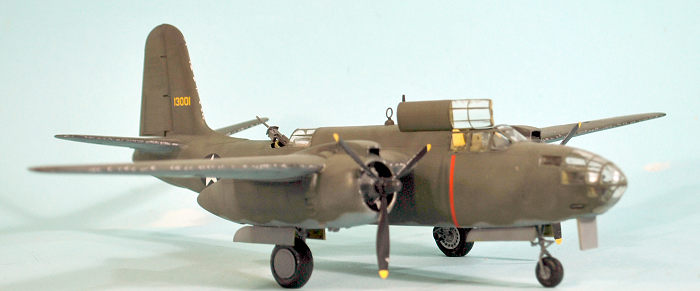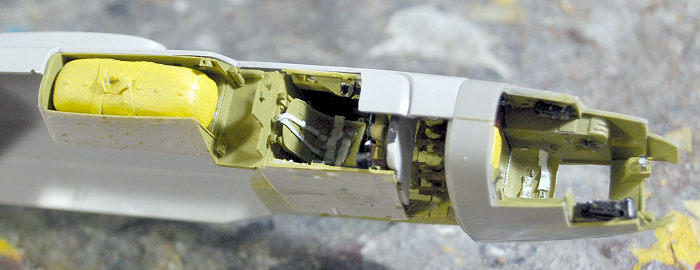
Italeri/AMT 1/48 A-20B Havoc
| KIT #: | 2656 |
| PRICE: | $39.95 'used' |
| DECALS: | Four options |
| REVIEWER: | Tom Cleaver |
| NOTES: | Vector Resin control surface and cockpit |

| HISTORY |
The Army Air Corps issued a new specification for an attack aircraft in 1937. To meet this requirement, Douglas, with a design team headed by Ed Heinemann, developed the Model 7B, powered by two 1,100 hp Pratt & Whitney R-1830-S3C3-G Twin Wasp engines, with a heavier bombload of 2,000 lb. The competition included the North American NA-40, Stearman X-100, and Martin 167F.
The prototype Model 7B first flew on October 26, 1938. It attracted attention from the French Purchasing Commission visiting the United States. The Model 7B crashed on January 23, 1939 while demonstrating single-engine performance, killing the pilot and seriously injuring a French observer aboard. The presence of a foreigner on a test flight for an aircraft still under development caused a scandal. Despite the crash, the French were impressed enough to place an order for 100 aircraft on February 15, 1939, following this with an order for 170 more in October 1939.
 As a result of the French order, Heinemann carried out another major
redesign revision, creating a new deeper but narrower fuselage, accommodated a
pilot, bombardier and gunner. The wing was mounted lower than on the Model 7B,
while the engines were mounted in nacelles slung under the wings. Normal
bombload was 1,410 lb, or 1,800 lb in overload, with a defensive armament of
single 7.5mm MAC 1934 machine guns in dorsal and ventral mounts and four fixed
forward-firing guns in the nose.The revised aircraft, now called the DB-7, first
flew on August 17, 1939.
As a result of the French order, Heinemann carried out another major
redesign revision, creating a new deeper but narrower fuselage, accommodated a
pilot, bombardier and gunner. The wing was mounted lower than on the Model 7B,
while the engines were mounted in nacelles slung under the wings. Normal
bombload was 1,410 lb, or 1,800 lb in overload, with a defensive armament of
single 7.5mm MAC 1934 machine guns in dorsal and ventral mounts and four fixed
forward-firing guns in the nose.The revised aircraft, now called the DB-7, first
flew on August 17, 1939.
The Air Corps liked the DB-7 as an attack bomber, and in June 1939, ordered 186 aircraft powered by Wright R-2600 engines, under the designations A-20 and A-20A; the A-20s powered by 1,700 hp turbosupercharged R-2600-7 engines and the A-20As powered by 1,600 hp supercharged R-2600-3 or -11 engines. These had a larger vertical tail to cope with the increased power, a longer nose to give room for the bombardier/navigator, and more fuel. France ordered 100 DB-7As powered by the R-2600 but with the short nose of the DB-7 in October 1939, and 480 long-nosed DB-73s, equivalent to the A-20A, in April 1940. Britain ordered 300 DB-7Bs equivalent to the A-20A in February and April 1940.
A test pilot report to the A&AEE at Boscombe Down stated the airplane "has no vices and is very easy to take off and land ... The aeroplane represents a definite advantage in the design of flying controls ... extremely pleasant to fly and manoeuvre." Pilots often considered it their favorite aircraft of the war due to the ability to toss it around like a fighter. The A-20 series found a role in every combat theater of the war, and excelled as a true "pilot's airplane".
The A-20B received the first really large order from the Army Air Corps, for 999 aircraft. These resembled the DB-7A rather than the DB-7B, with light armor and stepped rather than slanted glazing in their noses. 665 of these were exported to the Soviet Union
When series production ended on September 20, 1944, 7,098 A-20s had been built by Douglas and a further 380 by Boeing.
The 47th Bombardment Group (Light) was created on November 20, 1940. On January 15, 1941 the Group was activated at McChord Field, Washington with three squadrons, the 84th, 85th and 86th. The original cadre came from the 17th Bombardment Group. In the spring of 1941 the 47th Group, was stationed at Fresno, California flying from the new Hammer Field (today’s Fresno Metro Airport). They were equipped with B-18 bombers.
 Following Pearl Harbor, the 47th was assigned to anti-submarine patrols
on the Pacific Coast until they were re-equipped with the A-20B Havoc attack
bomber and moved to Las Vegas and later Oklahoma City for training.
Following Pearl Harbor, the 47th was assigned to anti-submarine patrols
on the Pacific Coast until they were re-equipped with the A-20B Havoc attack
bomber and moved to Las Vegas and later Oklahoma City for training.
In September they picked up new A-20s equipped with long range tanks. The group was the first to fly the Atlantic in squadron-size formations over the North Atlantic delivery route from Halifax to Bluie West One in Greenland to Reykjavik,Iceland to Glasgow, Scotland, arriving in mid-October.
The 47th arrived in Casablanca in late November 1942, and moved to Youks les Bain airfield in January, when they entered combat, moving forward to Thelepte in southern Tunisia. German fighters opposed almost all missions in the beginning. Their base at Thelepte was regularly attacked by the Luftwaffe. During the German attack at Kasserine Pass, they had to defend their airfield, making low-level attacks on panzer columns to allow the ground unit to retreat back to Youks les Bains. The 47th was awarded its first Distinguished Unit Citation for this action.
The most important day of the North African campaign was seven attacks in strength on German airfields at La Fauconnerie, Tunisia on April 7, 1943.
Following the German-Italian surrender in May 1943, the 47th took part in the Pantelleria campaign in June, then moved to Malta in July for the Sicilian campaign. After supporting the fighting in southern Italy through the breakthrough at Cassino, the group moved to Corsica and participated in the invasion of southern
France. Returned to Italy, the A-20s were used for night interdiction in the Brenner Pass campaign that winter. They received a second DUC for a 60-hour all-out bombing campaign over three days and nights following the Allied offensive in the Po Valley that began on April 15, that stopped evacuation of German units from Bologna in the final campaign before the German surrender in Italy at the end of the month.
| THE KIT |
 AMT released a series of A-20 kits including the A-20B/Boston II, A-20G,
A-20J and P-70 in the mid-90s. When AMT quit model airplane production in 2000,
the molds were later obtained by Italeri and re-released. The kits are overall
accurate and are likely the only 1/48 kits of this important aircraft that will
be produced. Italeri’s releases have been on and off, but both Italeri and
earlier AMT kits can be found at decent prices.
AMT released a series of A-20 kits including the A-20B/Boston II, A-20G,
A-20J and P-70 in the mid-90s. When AMT quit model airplane production in 2000,
the molds were later obtained by Italeri and re-released. The kits are overall
accurate and are likely the only 1/48 kits of this important aircraft that will
be produced. Italeri’s releases have been on and off, but both Italeri and
earlier AMT kits can be found at decent prices.
Vector Resins has produced resin control surfaces with nice fabric detail, cockpits for the A-20B, A-20G and Boston III, and resin bombardier noses for the A-20B, Boston III and A-20J, as well as R-2600 engines. These are all to Vector’s high standards of accuracy and production quality, and are worth getting since they really improve the look of the completed model. Decals for A-20s have been released over the years from several companies, and these can also be found at decent prices.
| CONSTRUCTION |
When the A-20 series was first released by AMT 25-plus years ago, I made one of each, which are now on display out at Planes of Fame for the past few decades.
I found this kit at the LHS estate sale this summer for a price too good
to pass up, with the purchase stimulated by the Desert War 1940-43 Group Build
currently going on at iModeler. I had planned to just build the model OOB, but
after seeing photos of two other A-20 models that used the Vector Resins sets
and noting the nice results, I picked up the flight controls, pilot’s cockpit
and bombardier’s compartment for use
 in this project. These are excellent sets
that fit perfectly and really add to the model. I didn’t get the engines or the
resin props, because you really can’t see that much of the engine once it’s
inside the cowling. When I do the A-20G I also picked up, I will get the resin
replacement cowlings, which are more accurate than what’s in the kit.
in this project. These are excellent sets
that fit perfectly and really add to the model. I didn’t get the engines or the
resin props, because you really can’t see that much of the engine once it’s
inside the cowling. When I do the A-20G I also picked up, I will get the resin
replacement cowlings, which are more accurate than what’s in the kit.
Other than cutting off the plastic control surfaces, assembly of the model was straightforward. I filled the lower fuselage behind the nose gear well and beneath and behind the pilot’s cockpit with as much weight as I could cram in, since I remembered the model had been a notorious tail-sitter the first time around.
I made some scratch-build interior walls for the gunner’s cockpit, which doesn’t have much detail in the kit.
When I assembled the landing gear, I positioned the nose gear closer to the top edge of the gear well, just inside it, which extended the gear to get the proper slightly-nose up “sit” of the A-20. There are some good resin wheels by Vector for this kit, but I decided to go the cheap route by sanding down the “tractor tread” of the kit wheels. I think I will use resin wheels on the A-20G kit.
| COLORS & MARKINGS |
The A-20s of the 47th Bomb Group ended up at the finale of the North African campaign looking very distinctive with field-applied tan camouflage paint over their original Olive Drab. I thought of doing that, then found a photo on the net of “Buffalo Dave,” the A-20B markings option in the kit. The kit instructions have the airplane with an OD/Tan scheme, but looking at this photo carefully, what appear to be color lines on the fuselage are actually stains on the original print that was scanned. The fact the airplane does not have yellow-surround national insignia or a large plane-in-group number on the vertical fin - which all field-camouflaged A-20s show in photos, led me to believe that “Buffalo Dave” was in the original Olive Drab/Neutral Grey scheme, with the paint faded and weathered. I decided to do this.
I used Tamiya XF-81 RAF Dark Green, which is a match for pre-war USAAC
green-base OD, since both paints were based on specifica tions for the RFC World
War I color PC10. I used XF-53 Neutral Grey for the lower color.
tions for the RFC World
War I color PC10. I used XF-53 Neutral Grey for the lower color.
I began by painting the entire model flat black. I then “mottled” that surface with blotches and squiggles of light grey. The camouflage colors were each applied with the paint thinned 50-50 and misted on, to allow the “pre-shading” to come through. The upper color was then “post-shaded” for sun fading and desert wear, in several progressively more-thinned coats that had additions of flat white, then light grey, then yellow to the original color, applied in blotches with a final very thin coat of the Dark Green, grey and some Tamiya “Desert Yellow applied overall, with emphasis added in to surfaces more exposed to sunlight and also to the fabric control surfaces. The end result is a multi-hue surface that looks close to a photo I found of a sun-faded A-20B in original camo.
I used the kit decals for the personal markings and serial. I used Yellow Wings national insignia, 40-inch roundels for the wing and 35-inch roundels for the fuselage.
I applied several coats of clear flat varnish to get a finish that looked sun-faded. I then “dinged” the airplane as the photo I was working from showed, with lots of dings on the leading edges of the wings and tail and scuffing on the wings, done with Vallejo “Dull Aluminum” and a 0000 brush. I finished with exhaust staining of the outer nacelle and upper wing area using Tamiya “Smoke.” I then unmasked the canopies for the gunner, pilot and bombardier; cutting the masks for the bombardier canopy was probably the most tedious and time-consuming part of the whole project. I attached the propellers and the hatch to the pilot’s cockpit and called it done.
| CONCLUSIONS |
The A-20 series is a very interesting airplane. There are a lot of interesting markings and camouflage options for the various air forces with which it served. The AMT kit is a good basis for a model, and can be dramatically improved with the use of the Vector Resins parts. Overall, I am quite happy with the final result.
30 September 2021
Copyright ModelingMadness.com. All rights reserved. No reproduction in part or in whole without express permission.
If you would like your product reviewed fairly and fairly quickly, please contact the editor or see other details in the Note to Contributors.